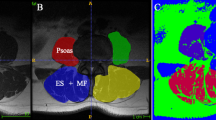Abstract
Purpose
The purpose was to investigate the changes of the psoas major muscles (PM) cross-sectional area (CSA) and fat infiltration in the PM and to investigate the association between the morphology of the PM and expression of the degenerative changes of lumbar spine in patients with low back pain (LBP).
Methods
T2-weighted scans for measurements of the CSA and analysis of fat infiltration were performed on 42 patients and 49 controls using a 1.5 Tesla MR system. For a quantitative analysis of fat tissue infiltration a 4-grade visual scale was used.
Results
Patients had bigger CSA of the PM than controls at the levels of L3/L4 and L4/L5 intervertebral disc (P < 0.05). Patients with apparent degenerative changes of the lumbar spine had smaller CSA of the PM compared to the patients without apparent changes at the levels of L3/L4 and L4/L5 (P < 0.05). At the levels of L4/L5 and L5/S1 patients with present Modic changes in the lumbar vertebral bodies showed smaller CSA of the PM compared to the patients without Modic changes (P < 0.05). However, CSA of the PM in the patients with degenerative changes of lumbar spine and Modic changes was still bigger than the one of the controls. At all analyzed levels correlation between CSAs of the PM and fat infiltration of the lumbar paraspinal muscles was negative.
Conclusion
Results suggest increased activity of the PM in LBP patients but PM also remains active regardless of the presence of degenerative and Modic changes of the lumbar spine.



Similar content being viewed by others
References
Urban JP, Roberts S (2003) Degeneration of the intervertebral disc. Arthr Res Ther 5:120–130
Mengiardi B, Schmid MR, Boos N, Pfirrmann CW, Brunner F, Elfering A, Hodler J (2006) Fat content of lumbar paraspinal muscles in patients with chronic low back pain and in asymptomatic volunteers: quantification with MR spectroscopy. Radiology 240:786–792
Kader DF, Wardlaw D, Smith FW (2000) Correlation between the MRI changes in the lumbar multifidus muscles and leg pain. Clin Radiol 55:145–149
Standring S (2005) Gray’s anatomy, 39th edn. The anatomical basis of clinical practice. Elsevier, Curchill Livingstone, Edinburgh, pp 1444–1446
Penning L (2002) Spine stabilization by psoas muscle during walking and running. Eur Spine J 11:89–90
Penning L (2000) Psoas muscle and lumbar spine stability: a concept uniting existing controversies. Eur Spine J 9:577–585
Bogduk N, Pearcy M, Hadfield G (1992) Anatomy and biomechanics of psoas major. Clin Biomech 7:109–119
Dangaria TR, Naesh O (1998) Changes in cross-sectional area of psoas major muscle in unilateral sciatica caused by disc herniation. Spine 23:928–931
Barker KL, Shamley DR, Jackson D (2004) Changes in the cross-sectional area of multifidus and psoas in patients with unilateral back pain: the relationship to pain and disability. Spine 29:E515–E519
Ploumis A, Michailidis N, Christodoulou P, Kalaitzoglou I, Gouvas G, Beris A (2011) Ipsilateral atrophy of paraspinal and psoas muscle in unilateral back pain patients with monosegmental degenerative disc disease. Br J Radiol 84:709–713
Parkkola R, Rytökoski U, Kormano M (1993) Magnetic resonance imaging of the discs and trunk muscles in patients with chronic low back pain and healthy control subjects. Spine 18:830–836
Danneels LA, Vanderstraeten GG, Cambier DC, Witvrouw EE, De Cuyper HJ (2000) CT imaging of trunk muscles in chronic low back pain patients and healthy control subjects. Eur Spine J 9:266–272
Ropponen A, Videman T, Battié MC (2008) The reliability of paraspinal muscles composition measurements using routine spine MRI and their association with back function. Man Ther 13:349–356
Kjaer P, Bendix T, Sorensen JS, Korsholm L, Leboeuf-Yde C (2007) Are MRI-defined fat infiltrations in the multifidus muscles associated with low back pain? BMC Med 5:2
Videman T, Battié MC, Gill K, Manninen H, Gibbons LE, Fisher LD (1995) Magnetic resonance imaging findings and their relationships in the thoracic and lumbar spine. Insights into the etiopathogenesis of spinal degeneration. Spine 20:928–935
Hansen L, de Zee M, Rasmussen J, Andersen TB, Wong C, Simonsen EB (2006) Anatomy and biomechanics of the back muscles in the lumbar spine with reference to biomechanical modeling. Spine 31:1888–1899
Zhao F, Pollintine P, Hole BD, Dolan P, Adams MA (2005) Discogenic origins of spinal instability. Spine 30:2621–2630
Ranson CA, Burnett AF, Kerslake R, Batt ME, O’Sullivan PB (2006) An investigation into the use of MR imaging to determine the functional cross-sectional area of lumbar paraspinal muscles. Eur Spine J 15:764–773
Hides J, Gilmore C, Stanton W, Bohlscheid E (2008) Multifidus size and symmetry among chronic LBP and healthy asymptomatic subjects. Man Ther 13:43–49
Modic MT, Ross JS (2007) Lumbar degenerative disk disease. Radiology 245:43–61
Rahme R, Moussa R (2008) The modic vertebral endplate and marrow changes: pathologic significance and relation to low back pain and segmental instability of the lumbar spine. AJNR Am J Neuroradiol 29:838–842
Albert HB, Manniche C (2007) Modic changes following lumbar disc herniation. Eur Spine J 16:977–982
Kjaer P, Leboeuf-Yde C, Korsholm L, Sorensen JS, Bendix T (2005) Magnetic resonance imaging and low back pain in adults: a diagnostic imaging study of 40-year-old men and women. Spine 30:1173–1180
Crombez G, Vervaet L, Lysens R, Baeyens F, Eelen P (1998) Avoidance and confrontation of painful, back-straining movements in chronic back pain patients. Behav Modif 22:62–77
Pfirrmann CW, Metzdorf A, Zanetti M, Hodler J, Boos N (2001) Magnetic resonance classification of lumbar intervertebral disc degeneration. Spine 26:1873–1878
Conflict of interest
None.
Author information
Authors and Affiliations
Corresponding author
Rights and permissions
About this article
Cite this article
Arbanas, J., Pavlovic, I., Marijancic, V. et al. MRI features of the psoas major muscle in patients with low back pain. Eur Spine J 22, 1965–1971 (2013). https://doi.org/10.1007/s00586-013-2749-x
Received:
Revised:
Accepted:
Published:
Issue Date:
DOI: https://doi.org/10.1007/s00586-013-2749-x




